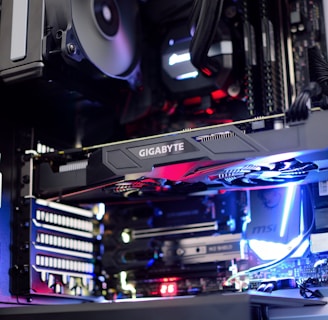
Tech Titans Clash
Intel, AMD, and NVIDIA’s Latest Innovations Reshape Computing
Hassan Shahid
1/27/20253 min read


Intel: Meteor Lake, Arrow Lake, and the Fight for AI Supremacy
Intel is staging a comeback with its most ambitious roadmap in years.
1. Meteor Lake (Core Ultra) Goes Mainstream
Intel’s Core Ultra processors (codenamed Meteor Lake) are now powering next-gen laptops, marking the company’s first major shift to a chiplet design. Built on the Intel 4 process (7nm equivalent), these chips combine:
AI-focused NPUs: Dedicated neural processors for tasks like background blur in video calls and local AI workloads.
Arc GPU Integration: Improved graphics performance for 1080p gaming without a discrete GPU.
Power Efficiency: 30% better battery life compared to previous-gen Intel laptops.
2. Arrow Lake: The Desktop Revolution
Coming late 2024, Arrow Lake will bring Intel’s chiplet architecture to desktops. Built on the Intel 20A node (2nm-class), it promises:
Lion Cove P-Cores: 15% faster single-threaded performance.
TSMC Collaboration: Some tiles manufactured by TSMC’s 3nm process for better efficiency.
AI Overhaul: Enhanced NPUs to compete with AMD’s Ryzen AI and Apple’s Neural Engine.
3. Gaudi 3: Challenging NVIDIA’s AI Crown
Intel’s Gaudi 3 AI accelerator, launching in late 2024, targets enterprise AI training and inference. Early benchmarks claim it’s 50% faster than NVIDIA’s H100 in specific workloads, with lower power draw. Paired with Intel’s OneAPI software suite, it’s a bid to carve space in the $200B AI chip market.
Challenges Ahead
Intel’s foundry business remains under pressure, but partnerships with UMC and plans for 1.8nm (18A) production by 2025 signal a long-game strategy.
AMD: Zen 5, RDNA 3.5, and the Data Center Surge
AMD continues to disrupt with its Zen architecture and aggressive data center play.
1. Ryzen 8000 "Strix Point"
AMD’s next-gen mobile processors, Ryzen 8000, will feature:
Zen 5 Cores: Up to 16 cores with a 20% IPC boost over Zen 4.
RDNA 3.5 Graphics: 40% faster GPU performance for 1440p gaming.
XDNA 2 NPU: Doubling AI performance to 50 TOPS, making it a rival to Intel’s Core Ultra.
2. Instinct MI300X and MI300A
AMD’s MI300X GPU, with 192GB of HBM3 memory, is gaining traction in AI data centers. Microsoft Azure and Meta have already adopted it for large language model training. Meanwhile, the MI300A (CPU+GPU hybrid) is NASA’s choice for upcoming supercomputing projects.
3. EPYC "Turin" for the Data Center
Late 2024 will see the launch of EPYC Turin, featuring Zen 5 cores and up to 256 threads per socket. With a focus on energy efficiency, AMD aims to dethrone Intel’s Xeon in cloud and enterprise markets.
The Road Ahead
AMD’s acquisition of Mipsology (AI software) and partnerships with TSMC’s 3nm node hint at a stronger focus on AI integration across its portfolio.
NVIDIA: Blackwell GPUs, Omniverse, and the AI Juggernaut
NVIDIA isn’t just leading the AI race—it’s redefining it.
1. Blackwell Architecture
NVIDIA’s RTX 50-series GPUs, based on the Blackwell architecture, are rumored for late 2024. Built on TSMC’s 3nm process, they promise:
2x Ray Tracing Performance: Thanks to new SM (Streaming Multiprocessor) clusters.
GDDR7 Memory: 36Gbps speeds for 4K gaming at 240+ FPS.
AI Tensor Cores: Enhanced for generative AI tasks like real-time DLSS 4.0.
2. Blackwell Data Center GPUs
The B100 and B200 GPUs, successors to the H100, are designed for trillion-parameter AI models. Key features:
Multi-Chip Design: Combining two GPUs into one for 5x training speed boosts.
Liquid Cooling Support: Tackling the power demands of 1000W+ TDPs.
Spectrum-X: A new Ethernet platform for AI-driven networking.
3. Omniverse and AI Ecosystem
NVIDIA’s Omniverse platform is now a cornerstone for industrial metaverse applications, with BMW and Siemens using it for digital twins. Meanwhile, CUDA 12.5 and AI Enterprise 5.0 are making it easier for developers to deploy AI models at scale.
The Bigger Picture
NVIDIA’s Grace Hopper Superchips (CPU+GPU combos) are powering next-gen supercomputers, while its robotics platform, Isaac AMR, is automating warehouses globally.
Head-to-Head: Who’s Winning What?
Gaming: NVIDIA still rules with DLSS and ray tracing, but AMD’s RDNA 3.5 is closing the gap.
AI Training: NVIDIA dominates, but AMD’s MI300X and Intel’s Gaudi 3 are credible threats.
Efficiency: AMD’s Zen 5 and Intel’s 20A node are leapfrogging each other in power-per-watt.
Challenges and Controversies
Power Consumption: High-end GPUs and CPUs now demand 500W+,
raising sustainability concerns.AI Ethics: All three companies face scrutiny over AI’s environmental impact and potential misuse.
Supply Chain: TSMC’s 3nm bottlenecks could delay launches for AMD and NVIDIA.
The Bottom Line
2024 is a pivotal year for Intel, AMD, and NVIDIA. Intel is betting big on AI integration and process node leadership, AMD is leveraging chiplet innovation to disrupt data centers, and NVIDIA continues to monetize the AI boom. For consumers, this rivalry means faster, smarter, and more efficient tech—whether you’re gaming, working, or building the next ChatGPT.
Stay tuned as these tech titans race to out-innovate each other—the only certainty is that computing will never be the same. 🚀
